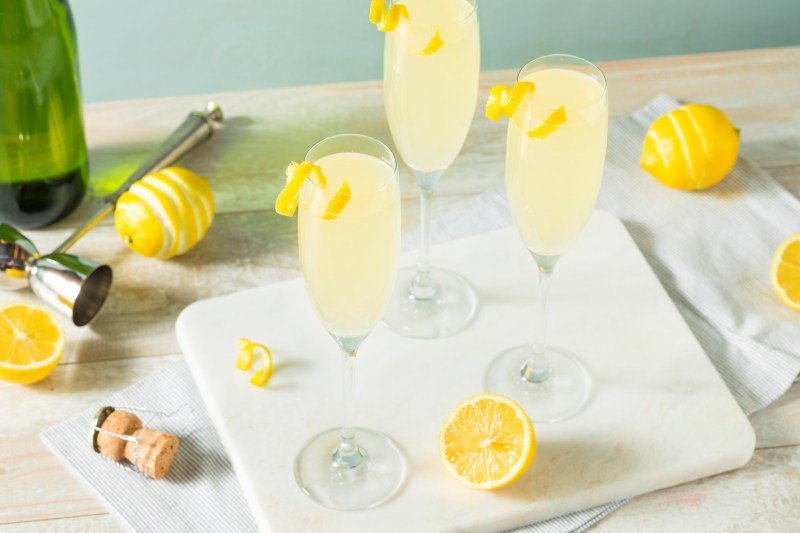
In the hierarchy of classic cocktails, the French 75 doesn’t get the respect it deserves. While boozier drinks like the Manhattan, Old Fashioned, and margarita get all the press, the French 75 cocktail is one of the easiest, freshest, most refreshing mixed drinks ever conceived and belongs more in the limelight. Even when it comes to gin-based drinks, it seems to often get overlooked in favor of gin and tonics, gin gimlets, and other drinks. This leaves us scratching our proverbial heads because it’s such a great drink. In the simplest terms, the French 75 ingredients are gin, Champagne, lemon juice, and sugar. That’s it. The sparkling wine is the main ingredient, making it an effervescent, delicious, sweet, citrus-filled experience. What’s not to love?

The French 75 Recipe
Ingredients
- 1 1/2 ounces gin
- 2 to 3 ounces Champagne
- 3/4 ounce lemon juice
- 3/4 ounce simple syrup
- lemon twist for garnish
Method
- Combine the gin, lemon juice, and simple syrup in a cocktail shaker.
- Add ice and shake vigorously for 20 seconds.
- Strain liquid into a flute glass.
- Top with Champagne.
- Garnish the glass with the lemon twist.

Weapon of mass intoxication
The cocktail dates back to the early 20th century and is named after the 75 mm field artillery gun used to devastating effect by the French during World War I. Capable of firing 15 rounds per minute, the soixante-quinze was a versatile all-around weapon, useful as both an anti-aircraft and anti-tank gun, which was more often used simply to rain down destruction upon troops in the trenches and in the open fields. Over the course of the war, a jaw-dropping 21,000 guns firing over 200 million shells had been used. More than a few correspondents at the time, like the Paris-based American journalist William P Simms, credit the French 75 for helping to win the war.
No one really knows who invented the drink and named it after the weapon. Some cocktail historians credit Harry MacElhone, owner of the famed Harry’s New York Bar, which became a favorite spot for American war veterans who stuck around Paris after the war. (As an aside, the atmospheric bar is still going strong today.) Others credit the less famous barkeep by the name of Henry Tépé, who ran Henry’s Bar, which curiously lies just around the corner from Harry’s in Paris’ 2nd arrondissement. Regardless of whether it was Harry, Henry, or a lesser-known barkeep, the drink took Paris by storm, and soon hopped across the channel and then the Atlantic where it was all the rage in London and Manhattan barrooms.
What is certain is that the original French 75 was quite different from today’s version. The first written record of the drink appeared in 1915 in the Washington Herald, and describes the Soixante-Quinze cocktail, or French 75, as consisting of equal parts gin, grenadine, and applejack, with a dash of lemon juice. The potency of the cocktail was compared to the lethal firepower of the French artillery weapon and British writers like Alec Waugh hailed it “the most powerful drink in the world.” The drink’s intoxicating efficacy only increased in the years following, when tastemakers like MacElhone subbed calvados for applejack and threw in some absinthe for good measure. Curiously, it was in the late 1920s — during America’s Prohibition era — that the French 75 was refined to its present-day recipe.

Variations on the French 75 cocktail recipe
Some drink specialists believe cognac rather than gin makes the perfect French 75, adding more warmth and complexity to the finished product. Arnaud’s French 75 Bar, which opened in 1918 in New Orleans, treats the cocktail with reverence (not surprising given the name of the place) and stirs one up with Courvoisier VS cognac and Moët & Chandon Champagne.
Once you’ve tasted the gin and cognac version, you can explore other boozy champagne and citrus combinations. The Mexican 75 uses tequila and lime juice rather than gin and lemon for a perfect sweet-and sour-combo, plus you can salt the rim for a more dramatic presentation. The Old Cuban takes a similar route only with rum rather than tequila — and includes muddled mint for extra freshness. The Maxwell is another classic champagne cocktail that’s ideal for summer drinking. It retains the lemon juice and champagne but throws out the other ingredients in place of cucumber vodka, cucumber juice, and Cointreau.

Foods that pair with the French 75 cocktail
Like with any cocktail, there’s a decent chance you’re going to want to pair food with the tart, sweet, effervescent French 75. While you can pair the drink with a whole meal, since it’s a well-known aperitif, we like to imbibe it while we nosh on an appetizer or two. It goes well with goat cheese and sharp cheddar cheese, as well as rich ham and salami. You can cut the zesty flavor with sweet honey-drizzled brie or by enjoying some berries, figs, or grapes. All in all, it’s a refreshing drink that begs to accompany light fare.
Editors' Recommendations
- How many shots are in a handle of liquor? We’ll walk you through it
- What is ice wine and why is it so special?
- The Macallan releases a limited-edition single malt scotch perfect for holiday gatherings
- Beer news: Left hand Brewing introduces Belgian White Nitro, the world’s first bottled wheat beer with nitrogen
- The Irish Whiskey Awards named this the best Irish whiskey of the year (and they should know)




